
CMS pages are located in virtual directory structure containing folders and pages. Page contains folowing components:
-
General data. General data contains folowing data:
- ID. Unique ID assigned to page (automatically if not specified). Can be used to access page directly by URL http://site_url/id. Request will be redirected to page actual URL.
- URL. Page main relative URL within site. Real page URL will be http://site_url/subsite_path/page_relative_url. Subsite path for main site is empty, '/cms/srv/admin' - for CMS administration tools subsite, '/cms/srv/api' - for CMS RESTful API, each CMS plugin has it's own subsite. Metadata:
- Title. For usage in site menu item
- Extended title. For usage in page HTML header section tag <title> (optional).
- Description. For usage in page HTML header section tag <meta> (optional).
- Keywords. For usage in page HTML header section tag <meta> (optional).
- Language. For usage in page HTML tag <html> (optional).
- Template. Comes from model if page has it assigned. May be assigned to page if page has no assigned model. Template may be selected from site templates list (must be prepared by administrator) or from site file system using CMS file manager. Will be used default CMS template if there is not assigned or specified in assigned model.
-
Options:
- Page code. May be used to distinguish different page types (optional).
- Cache lifetime. Time amount in seconds in within page will be taken from cache; other values: "-1" - unlimited lifetime, "0" - no cache (optional, caching must be turned on).
- Public. Page public availability; requires administrator login if is not public; may be defined time interval when page become public or not public (optional).
- Redirect. May be specified this page redirection to other page or site URL (optional).
- Method. Default method is "GET"; may be added ex. "POST" if page contains form submission (optional).
- Sitemap. Enable this page to be included into sitemap (for crawling sites, ex. Google); priority and changing frequency may be specified (optional).
- Search index. Enable this page to be searchable by site local search engine (optional).
-
Model. Model is special kind of page containing page presentation data.
Page presentation can be very easy changed for a number of pages sharing same model.
Model contains data to be used instead of page own data:
- Template
- JScript
- CSS
- Header options
- Redirect from URL. List of site URL's to be redirected to this page main URL (optional).
- Topic list. List of top classification terms to be used ex. to scope search; CMS sample site uses topics "eng", "lit", "rus" to scope site local search for different languages (optional).
- Content. List of template/HTML files to be included into page via template (optional).
- JScript. List of Java Script files to be included into page via template in addition to CMS include files (optional).
- CSS. List of CSS style sheet files (SASS and LESS are supported!) to be included into page via template in addition to CMS include files (optional).
- Header Options. List of optional text lines such as ex. <meta http-equiv="pragma" content="no-cache"/> to be included into page HTML header section (optional).
- Keypair Data. Key pair data assigned to this page; CMS sample site uses this ability to distinguish news pages such as actual, archive, etc. ex. key="news", data="year=2014" (optional).
- Data Streams. Implementation of digital object repository; more information http://www.kusoftas.com/docs/overview/basics/digital-objects-repository (optional).
- Access. Page access control list; more information http://www.kusoftas.com/docs/overview/basics/access-control (optional).
There is special sample kind of page with purpose to hold page samples to be applied to page at page creation time. Usage of samples may dramatically simplify new pages creation. It is same as regular page with exception of:
- Does not have URL
- Does not have URL alias list
- Content may have items with include file placeholders which must be replaced with real file path at the time when sample page content is applied to page.
